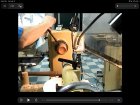Guess I can't edit the title with that typo 
Hi, I wondering what the optimal size was for tenons and recesses in relation to chuck jaws I guess I always heard a tenon should be as small as the jaws allow. But for recesses I've heard both large as possible and small as possible.
Any thoughts?
Thanks,
R
Hi, I wondering what the optimal size was for tenons and recesses in relation to chuck jaws I guess I always heard a tenon should be as small as the jaws allow. But for recesses I've heard both large as possible and small as possible.
Any thoughts?
Thanks,
R
Last edited:

